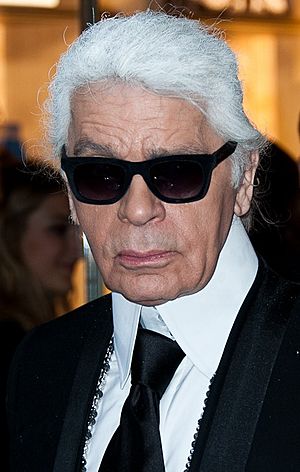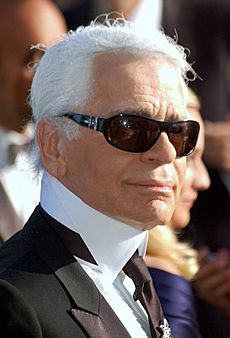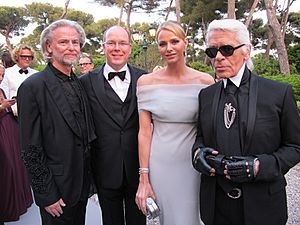Karl Lagerfeld facts for kids
Quick facts for kids
Karl Lagerfeld
|
|
|---|---|

Lagerfeld in 2014
|
|
| Born |
Karl Otto Lagerfeld
10 September 1933 |
| Died | 19 February 2019 (aged 85) Neuilly-sur-Seine, France
|
| Education | Lycée Montaigne, Paris |
|
Label(s)
|
|
| Partner(s) | Jacques de Bascher (1971–1989, his death) |
| Parent(s) |
|
| Signature | |
Karl Otto Lagerfeld (born September 10, 1933 – died February 19, 2019) was a famous German fashion designer. He was also a creative director, artist, and photographer.
Lagerfeld was best known for being the creative director of the French fashion house Chanel. He held this important job from 1983 until he passed away. He also led the Italian fashion house Fendi, which makes fur and leather goods. Besides these, he had his own fashion brand named after himself. He worked on many different fashion and art projects throughout his life.
People easily recognized Lagerfeld by his unique look. He always had white hair, wore black sunglasses, fingerless gloves, and high, stiff collars.
Contents
Growing Up: Karl Lagerfeld's Early Life
Karl Lagerfeld was born on September 10, 1933, in Hamburg, Germany. His mother was Elisabeth, and his father was Otto Lagerfeld, a businessman. His father owned a company that made and imported evaporated milk. Karl's family was part of the Old Catholic Church.
Karl sometimes told people he was born in a different year. He also changed details about his parents' backgrounds. For example, he sometimes said he was born in 1938. But records show he was born in 1933. His parents published a birth announcement that year. His baptism records in Hamburg also confirm his birth date.
Karl had an older sister named Martha Christiane. He also had an older half-sister, Theodora Dorothea, from his father's first marriage. The family name was sometimes spelled "Lagerfeldt." But Karl, like his father, used "Lagerfeld." He thought it sounded "more commercial."
During World War II, his family was mostly safe from hardship. This was because of his father's successful business. As a child, Karl loved visual arts. His old school friends remembered him always sketching. He said he learned more by visiting the Kunsthalle Hamburg museum than in school.
Karl Lagerfeld's Amazing Career
Starting Out: Chloé and Fendi (1954–1982)
In 1954, Karl Lagerfeld entered a design competition. He designed a dress that looked like styles that would become popular later. In 1955, he won a coat design competition. He became friends with Yves Saint Laurent. Soon after, he worked as an assistant for Pierre Balmain for three years.
In 1958, Lagerfeld became the artistic director for Jean Patou. In 1964, he moved to Rome to study art history. He also started designing for many brands as a freelancer. These included Charles Jourdan, Chloé, Krizia, and Valentino.
In 1967, Fendi hired him to update their fur collection. Lagerfeld's designs were very new and exciting. He started using furs like mole, rabbit, and squirrel in high fashion. Lagerfeld stayed with Fendi until he passed away.
In the 1970s, his work for Chloé made him one of the world's top designers. He often competed with Yves Saint Laurent for who was most influential. He created a "Soft Look" style. This meant clothes were loose, comfortable, and layered. Later, he changed to more structured looks. These included large shoulder pads that became popular in the 1980s.
Becoming Famous: Chanel (1982–2000)
In the 1980s, Lagerfeld joined Chanel. At that time, Chanel was not doing very well. The founder, Coco Chanel, had died ten years earlier. Lagerfeld took over the couture (high fashion) in 1983. He brought the company back to life. He made it a huge success by updating its ready-to-wear clothing line. Lagerfeld also used the famous interlocking "CC" logo of Coco Chanel in new ways.
He changed the classic Chanel style. He added shoulder pads, made skirts shorter and tighter, and used bigger or smaller jewelry. In 1984, a year after starting at Chanel, Lagerfeld launched his own brand, "Karl Lagerfeld." He was very successful during the 1980s. He brought back many historical styles.
Later Years: Fashion and Art (2001–2019)
Fashion Projects
In 2002, Lagerfeld worked with Renzo Rosso, who started Diesel. They created a special denim collection. It was called Lagerfeld Gallery by Diesel. The collection had five pieces shown during Paris Fashion Week. They were sold in limited numbers in Paris, Monaco, New York, and Tokyo. The clothes were quite expensive, but they sold out quickly.
In 2006, Lagerfeld launched a new collection called K Karl Lagerfeld. It included fitted T-shirts and jeans. In 2010, he received an award for his vision in fashion. He also worked with the Swedish crystal company Orrefors. They designed a crystal art collection together.
In 2012, Lagerfeld released a photo-book called The Little Black Jacket. It featured many famous people and his friends. In 2014, some of his early sketches were sold at an auction. People called Lagerfeld the "Chameleon of fashion." This was because he could take the history of fashion houses and make it modern. In 2015, he received an award for his amazing achievements in fashion.
Final Collection
The last Chanel collection Lagerfeld finished before he died had an Alpine theme. It featured après-ski clothing. Lagerfeld did not want a formal funeral. So, his final show included a moment of silence for him. Some models and audience members were seen crying.
Other Creative Work
Lagerfeld also worked on other projects. He signed a deal to design special homes on an island in Dubai. A documentary film about him, Lagerfeld Confidential, was made in 2007. He even voiced a character in the video game Grand Theft Auto IV.
In 2008, he created a teddy bear that looked like him. It sold for $1,500. He was also made into pins, dolls, and finger puppets. In 2009, he lent his voice to a French animated film. Later in his life, Lagerfeld became a professional caricaturist. His political cartoons were published in a German newspaper.
In 2013, he directed a short film called Once Upon a Time.... It starred Keira Knightley as Coco Chanel. In 2016, he designed the lobbies for a residential building in Miami. In 2018, Lagerfeld launched an art collection. It featured sculptures made of marble.
Karl Lagerfeld's Personal Life
Karl Lagerfeld was known for his unique style. He always had white hair, black sunglasses, fingerless gloves, and high, stiff collars.
He lived in many different homes over the years. These included apartments in Paris and Monte Carlo. He also owned a chateau in Brittany and a villa in Hamburg. From 2007, he owned a house in Paris decorated in modern and Art Deco styles.
Lagerfeld had a red point Birman cat named Choupette. He joked that he would marry her if it were legal.
Weight Loss Journey
In 2001, Lagerfeld lost 42 kilograms (92 pounds). He explained that he wanted to wear clothes designed by Hedi Slimane. These clothes were for very slim people. So, he needed to lose a lot of weight. It took him 13 months. A doctor created a special diet for him. This diet later became a book called The Karl Lagerfeld Diet. He talked about it on TV shows.
Love for Books
Lagerfeld loved collecting books. He had one of the largest personal libraries in the world. He once said he had 300,000 books. He said he only collected books and had no room for anything else.
Remembering Karl Lagerfeld
Death and Tributes
In January 2019, Lagerfeld had health problems. He was admitted to the American Hospital of Paris on February 18. He passed away the next morning from complications of pancreatic cancer. Lagerfeld had asked for no formal funeral. He wanted to be cremated. His ashes were to be spread in secret locations.
On June 20, 2019, a special event honored Lagerfeld. It was called "Karl For Ever" and took place at the Grand Palais. This celebration looked back at his career at Chloé, Fendi, and Chanel. About 2,500 guests attended. Large portraits of him were displayed. The event also included readings and music. Famous people like Tilda Swinton, Cara Delevingne, and Pharrell Williams performed.
After the memorial, the Karl Lagerfeld brand announced "The White Shirt Project." This project honored the designer's legacy. It featured a collection of redesigned white shirts. Lagerfeld once said that if he could have invented anything in fashion, it would be the white shirt. He believed it was the basis of everything.
The project was led by Karl Lagerfeld's style adviser, Carine Roitfeld. It included designs from many famous people. Seven of the final designs were made 77 times. They were sold for €777 each. All the money went to a French charity that funds medical research.
Images for kids
See also
 In Spanish: Karl Lagerfeld para niños
In Spanish: Karl Lagerfeld para niños




